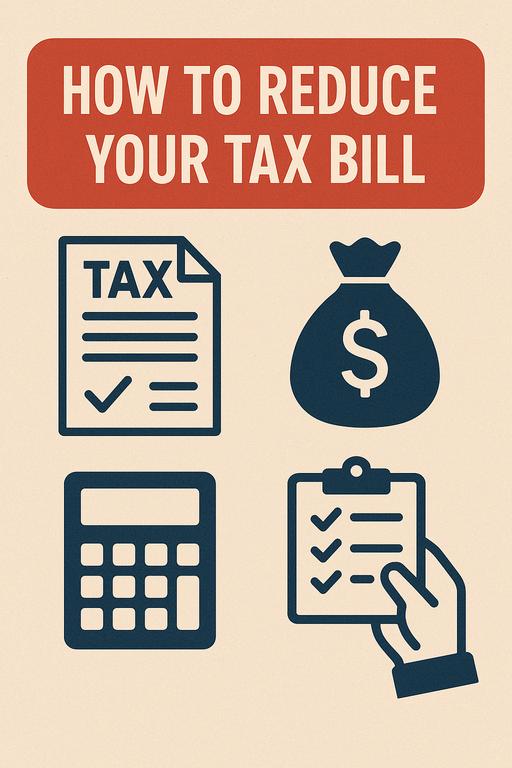How to Reduce Your VAT Bill: 7 Legit Strategies for 2025
Slash your VAT liability without crossing the line these expert-backed tips are fully HMRC-compliant

Want to pay less VAT without raising any red flags?
You're not alone As costs climb in 2025, smart businesses are digging deeper into legal ways to reduce their VAT bills.
Here are the proven tactics that tax pros use (and most small businesses still miss)
1. Claim All Eligible Input VAT — Without Overstepping
Most businesses underclaim VAT simply because they don’t know what qualifies
● Include pre-registration expenses if applicable (you can claim back up to 6 months for services, 4 years for goods).
● Don’t forget business-related mobile bills, subscriptions, and travel.
● Track mixed-use assets carefully and apply the correct business-use percentage
Tip: Review the past 4 quarters and make any corrections via an adjustment on your next return.
Spent on business travel? Reclaim your GST/HST the right way
2. Use the VAT Flat Rate Scheme (If You Qualify)
For small businesses under £150,000 turnover, the Flat Rate Scheme can reduce admin and, in some cases, your overall VAT liability. You charge standard VAT but pay HMRC a fixed lower rate (based on your sector)
Ideal for service-based businesses with low input VAT claims.
Pro move: Use a tool like vatcalc.onl to compare Flat Rate Scheme vs. Standard VAT costs before enrolling Built for UK VAT rules in 2025, it handles sector-specific rates and input VAT exclusions, making it easy to assess which option offers better cost efficiency and compliance.
NHS staff in 2025? Find your real take-home pay with this detailed calculator
3. Time Your Invoices and Payments Strategically
VAT is based on tax points when an invoice is issued or payment is received
● Delay invoicing until after a VAT quarter if it keeps income within limits.
● Where appropriate, prepay allowable expenses to boost input VAT in a high-output quarter.
For Canadian businesses navigating HST compliance, hstcalculator.onl provides accurate simulations of net, gross, and tax components across all provincial HST rates from Ontario’s 13% to Nova Scotia’s 15% This tool supports precise CRA remittance planning, helps avoid input tax credit errors, and is widely used by accountants, ecommerce platforms, and SaaS startups operating nationwide
Note: Timing alone won’t reduce VAT long-term, but it can smooth spikes and improve cash flow
4. Reclaim VAT on Bad Debts
If you've written off a debt, you may be able to reclaim the VAT already paid on that invoice.
● The debt must be over 6 months old, written off in your accounts, and previously declared in your VAT return
● Use Box 4 of your VAT return to adjust for the input tax
Many businesses forget this reclaiming bad debt VAT could add thousands back to your cash flow.
5. Zero-Rate and Exempt Supplies Use Them Wisely
Not all sales require VAT collection:
● Exports outside the UK
● Educational/training services
● Books/publications
Mixing exempt and standard-rated sales requires partial exemption calculations but can reduce VAT due
Strategy: Assess your service/product mix and explore restructuring if zero-rated opportunities exist
6. Split Your Business (Legally) If You're Near the Threshold
Running multiple distinct businesses under one VAT registration can increase liability unnecessarily
HMRC allows separate VAT registrations for independent business entities but only if they’re truly distinct (different activities, customers, teams)
Caution: Avoid artificial splitting it’s a compliance risk. Always consult a VAT expert before restructuring for this purpose.
Nonprofits: Claim your 50% HST rebate—see who qualifies
7. Use Annual Accounting or Cash Accounting Schemes
Both can delay VAT payments and help with budgeting:
● Annual Accounting: One return a year with fixed payments throughout.
● Cash Accounting: Pay VAT only on invoices you’ve actually been paid for.
Ideal for businesses with cash flow lags or inconsistent payment terms
Which VAT-saving strategy surprised you most?
Let’s compare notes in the comments your experience could inspire someone else’s win And if you’re serious about mastering VAT in 2025, tap “Follow” for more expert guides and real-world tips
CRA just froze the 2025 TFSA limit—here’s what it means for you
